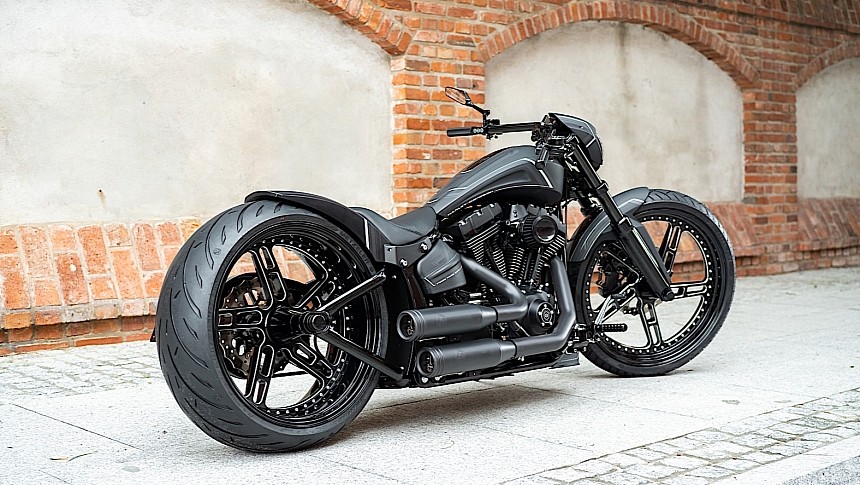For the ones with a passion for wheeled machines, the name Challenger can stand for only one thing: a muscle car made by Dodge that has been wowing onlookers and setting strip records ever since its inception in the early 1970s.
For the automobile, the name Challenger couldn't be more suitable. After all, a challenger is someone or something who always engages in a competition with the goal of winning. And the Dodge is known to do that a lot.
Because of its generous meaning, the moniker was borrowed and used by other products of human ingenuity, from spaceships to music bands. Of interest to us today is a motorcycle named so, a muscle ride in the purest form assembled for a world champion.
The Challenger we have here was originally called a Harley-Davidson Breakout. It left the factory doors in 2015, and somehow crossed paths with the guys from Polish custom garage Nine Hills who decided to make it as a ride for Nicki Pedersen.
The Danish national, now aged 46, made a name for himself in motorcycle speedway racing, where he was crowned champion no less than three times, in 2003, 2007, and 2008. The man was on the starting grid of 178 races in the Speedway Grand Prix, scoring 49 podium wins and 16 absolute wins.
It's because of the racer's competitive nature that Nine Hills chose to name their project Challenger. And in line with that, the crew made the two-wheeler look like an exquisite display of muscle fiber, with no trace of fat.
If you don't know what you're looking at it's almost impossible to identify this as a Breakout. Both of the original wheels are gone, replaced by much wider hardware sourced from Thunderbike. They are now sized at 23 inches in front and an impressive 21 inches at the rear, giving the bike a stance not often seen, even on custom projects.
With these modifications the Harley fenders had to go as well, and that's what they did. The wheels were tied to a Legend air suspension system.
Then came work on the bodywork, which was significantly lightened by removing unnecessary covers and even the fuel tank. The new piece to hold fuel is now longer and slimmer, going down toward the back in such a way as to seem it blends with the bike's frame.
The names of other of the custom bike industry's greats can be seen elsewhere on the machine. Rebuffini supplied the hand gear, Roland Sands Design provided the foot controls, and KessTech the exhaust system, the only modification made to the bike's otherwise stock engine.
The cost of the bike was not disclosed, nor do we know what happened to it since Nine Hills completed it, but when did that ever stop us from enjoying a proper custom bike?
Because of its generous meaning, the moniker was borrowed and used by other products of human ingenuity, from spaceships to music bands. Of interest to us today is a motorcycle named so, a muscle ride in the purest form assembled for a world champion.
The Challenger we have here was originally called a Harley-Davidson Breakout. It left the factory doors in 2015, and somehow crossed paths with the guys from Polish custom garage Nine Hills who decided to make it as a ride for Nicki Pedersen.
The Danish national, now aged 46, made a name for himself in motorcycle speedway racing, where he was crowned champion no less than three times, in 2003, 2007, and 2008. The man was on the starting grid of 178 races in the Speedway Grand Prix, scoring 49 podium wins and 16 absolute wins.
It's because of the racer's competitive nature that Nine Hills chose to name their project Challenger. And in line with that, the crew made the two-wheeler look like an exquisite display of muscle fiber, with no trace of fat.
If you don't know what you're looking at it's almost impossible to identify this as a Breakout. Both of the original wheels are gone, replaced by much wider hardware sourced from Thunderbike. They are now sized at 23 inches in front and an impressive 21 inches at the rear, giving the bike a stance not often seen, even on custom projects.
With these modifications the Harley fenders had to go as well, and that's what they did. The wheels were tied to a Legend air suspension system.
Then came work on the bodywork, which was significantly lightened by removing unnecessary covers and even the fuel tank. The new piece to hold fuel is now longer and slimmer, going down toward the back in such a way as to seem it blends with the bike's frame.
The names of other of the custom bike industry's greats can be seen elsewhere on the machine. Rebuffini supplied the hand gear, Roland Sands Design provided the foot controls, and KessTech the exhaust system, the only modification made to the bike's otherwise stock engine.
The cost of the bike was not disclosed, nor do we know what happened to it since Nine Hills completed it, but when did that ever stop us from enjoying a proper custom bike?










